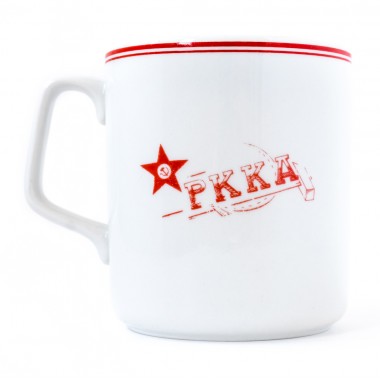Description
Porcelain mug for tea or beer with the inscription БУФЕТ КООПЕРАТИВА СОТР и ВОЙСК Г.П.У. (Buffet of the cooperative of employees and military of the G.P.U.). The inscription is copied from the original subject of agitation porcelain. Such porcelain is also called propaganda-dishes; it was one of the tools to create a positive image and importance of the organization, along with uniforms, special insignia and unique awards. We offer here a beautiful item for domestic use, which is undoubtedly a great gift!
A durable mug of a convenient shape weights approximately 300 g and holds 330 ml of liquid. Diameter 8 cm, height almost 10 cm. The inscriptions are applied as hot decals (paint is baked into the surface at high temperature), this is not a cheap stencil. The inscriptions are fixed securely and can be washed in a dishwasher.
On the bottom there is the manufacturer's marking: the N.K.M.P. icon in the form of related letters, the abbreviation of the RSFSR over a schematic representation of a porcelain product, and under it is "Proletarij, Msta". This is the mark of the Proletarij plant from 1939-1940 (according to information from the site farfor.club). It was under the N.K.M.P. or Narkommestprom (People’s Commissariat for Local Industry). Since 1920 in the USSR small and medium-sized enterprises whose products and services were intended for local consumption were considered a separate branch of the economy (in comparison with large strategic enterprises). At the same time, such factories created that unique objects. This factory should not be confused with the "Proletarij" porcelain factory (until 1922 the Kornilov brotherhood partnership). The "Proletarij" plant near the Msta river in the Novgorod province (or rather, on the banks of the Nisha river) was founded in 1882 on the initiative of Mr. Reichel. In 1893, in the hands of Ivan Emelyanovich Kuznetsov (the owner and other porcelain factories), the enterprise began to be called the Bronnitsky porcelain and earthenware factory. And since November 1922, at the initiative of the workers, the enterprise was renamed the "Proletarij". Since 1925, "Proletarij" or "proletaian" has completely switched to the production of porcelain. Sources: ru.wikipedia.org, rusmodern.com, farfor-antik.ru, sovfarfor.com.
The Workers 'and Peasants' Red Army (RKKA) — the ground forces of the RSFSR in 1918-1922 and the USSR in 1922-1946 (that is, approximately from the formation of the Soviet Republic until the end of World War II). An interesting feature is that there is almost no abbreviation of the Red Army or the name "Worker and Peasant Red Army" in the army documents from the summer of 1941. The name "Red Army" is commonly used. The abbreviation RKKA or the name "Worker-Peasant Red Army" is used mainly in solemn occasions. Source: ru.wikipedia.org и army.armor.kiev.ua.
Below are photos of Tatyana Este demonstrating the use of copies and originals of dishes with the symbols of the Red Army:





























